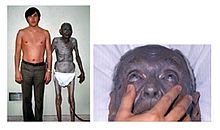Argyria
| Classification according to ICD-10 | |
|---|---|
| T56 | Toxic effect of metals |
| T56.8 | Other metals |
| ICD-10 online (WHO version 2019) | |
Argyria (from ancient Greek ἄργυρος argyros , German 'silver' ) is an irreversible, slate-gray or gray-bluish discoloration of the skin and mucous membranes , which is caused by the ingestion of silver (as metallic silver, silver dust, colloidal silver , drugs containing silver or silver salts ) and is counted as a disease to the dyschromias . Argyria can occur both generalized and locally as argyrosis. Argyria seems to have become a rather rare disease after a "peak" at the beginning and middle of the 20th century. Argyria is sometimes confused with the term agyria .
The term argyria goes back to the German doctor Johann Abraham Albers from Bremen, who introduced the term in 1816.
The generalized form of argyria
In the generalized form of argyria, the entire surface of the skin is affected by the discoloration, especially in areas that have been exposed to sunlight.
In the past argyria was observed after taking silver-containing nasal drops , silver-containing drugs, silver-containing smoking cessation tablets, silver dusts, silver-containing lozenges and colloidal silver, among other things . Occupational exposure to silver salts or silver dust was also a cause of argyria in the past. The gray color of the skin is caused by the light-influenced storage of silver-containing granules. Silver sulfide was repeatedly detected in these granules . The silver deposits are in the skin, especially in areas that have been exposed to sunlight. These silver-containing "granules" are found in Argyrics especially near the sweat glands, but also near the basement membrane. But silver can also be deposited in other organs. In addition to the deposits, there is also an increased synthesis of melanin , which also influences the discoloration of the skin. The top layer of skin, the epidermis , is not affected by the silver deposits. Regular renewal of the epidermis cannot therefore help to reduce the discoloration. In order to cause generalized argyria, large amounts of silver are required. The cumulative intake of more than one gram of silver can already lead to argyria, according to a publication by the US Environmental Protection Agency . Older information from the specialist literature assume minimal amounts of 1.5 to 1.8 grams. Argyria has to be differentiated from acute silver intoxication and so far there are only very few other symptoms besides the skin discoloration that have been scientifically described in connection with argyria. These include night blindness and kidney failure. One of the first discolorations observed in argyria is that of the lunulae of the fingernails.
The argyrosis
The argyrosis is that of argyria appropriate localized deposition of silver, mostly in the eye. Local discoloration by silver has been observed in silver earrings, silver-based make - up , local application of silver nitrate, silver acupuncture needles left in the tissue for a long time, and the use of silver-containing surgical sutures. Since silver also has antimicrobial and low antiviral properties with an appropriate exposure time, it is used to support wound healing and high silver concentrations in the wound area have in the past in rare cases led to a local, but permanent discoloration.
Amalgam tattoo (English amalgam tattoo) or mucous membrane tattoo are rare discolorations of the gums, which are attributed to the fact that amalgam particles (also containing silver, then also known as silver amalgam) are introduced into injured gums during dental treatment using drills and can then lead to local discoloration.
Therapy of argyria
A satisfactory therapy for this disease (which represents a considerable and stigmatizing cosmetic problem for those affected) is not known. Laser treatments of the skin and therapies with high doses of vitamin E and selenium are currently being tested.
literature
- A. Wadhera, M. Fung: Systemic argyria associated with ingestion of colloidal silver. In: Dermatology online journal. Volume 11, number 1, 2005, p. 12, ISSN 1087-2108 . PMID 15748553 . (Review).
- BA Bouts: Images in clinical medicine. Argyria. In: The New England Journal of Medicine , Volume 340, Number 20, May 1999, p. 1554, ISSN 0028-4793 . doi: 10.1056 / NEJM199905203402006 , PMID 10332018 .
- Newspaper article on argyria cases after taking colloidal silver :
- Florian Leu: The blue gringo. In: Neue Zürcher Zeitung. Folio, May 2014; Retrieved May 5, 2014.
- American has lived with a blue face for 14 years. krone.at, December 21, 2007; Retrieved May 5, 2014.
Web links
Individual evidence
- ↑ JA Albers: Observations on a change of color in the skin, produced by the internal use of the nitrate of silver. In: Medico-surgeon. Trans. , 1816, 7, p. 284.
- ↑ Silver (CASRN 7440-22-4). on: epa.gov (information from August 6, 2006)
- ^ WR Hill, DM Pillsbury: Argyria: The pharmacology of silver. Williams & Wilkins Co., Baltimore 1939. (Original quote: "The minimum amount of silver known to cause argyria in adults, from the use of any silver compound (including salts) is 900 mg of silver taken orally in one year".)
- ^ LE Gaul, AH Staud: Seventy cases of generalized argyria following organic and colloidal silver medication, including biospectrometric analysis of ten cases. In: AMA , 104, 1935, pp. 1387-1390.
